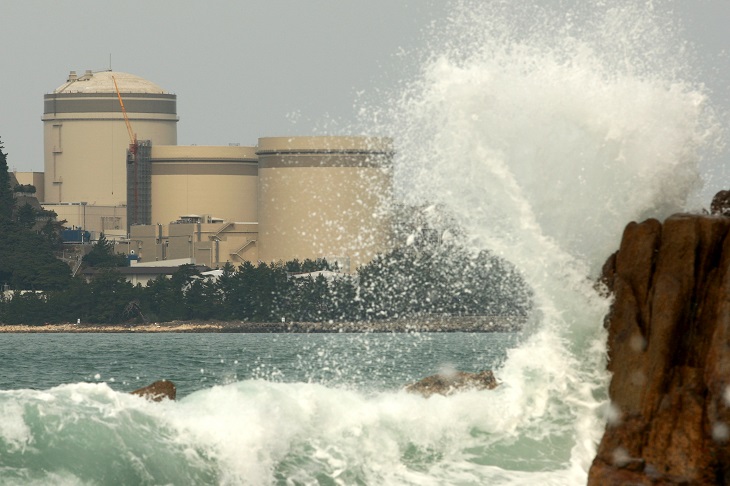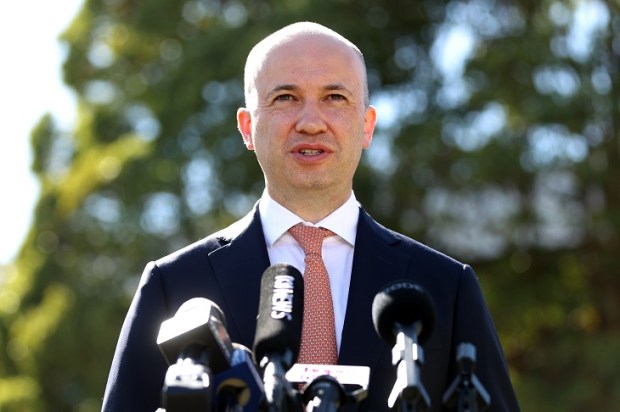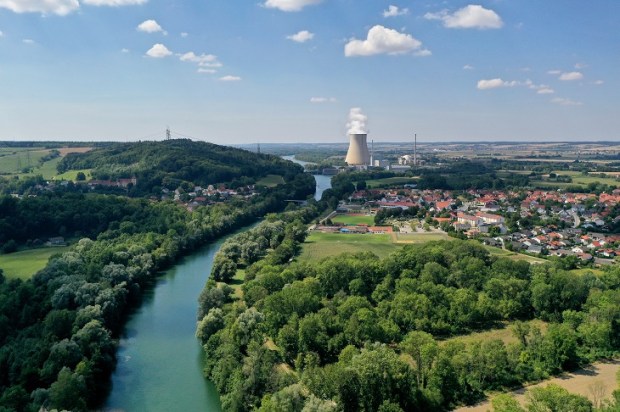One of the more popular memes on social media is: ‘Worst Prime Minister Ever’. The label is variously applied to both the current Prime Minister and the previous one.
Historically, Albanese and Morison are small fry, and no serious discussion of this competition can be conducted without considering the two most outstanding candidates – Gough Whitlam and Billy McMahon.
Personally, my vote goes to McMahon, as he is the person most responsible for the nuclear-free state of our country.
We almost had a nuclear power station in 1971 at Jervis Bay on the New South Wales south coast. They cleared the land, put in the footings, built the access road, and then, when McMahon took over from Gorton in March of that year, he scrapped it. As a consequence, visitors to Murrays Beach on the southern tip of the entrance to the bay find themselves on a modern, dual-carriageway road that finishes at a boat ramp.
And so here we are today, without a nuclear power plant in Australia and, worse, a ban on building one.
Nuclear energy was once again thrust into the world spotlight a decade ago during the Fukushima crisis in Japan. As Australia faces an uncertain future in terms of electricity supply, where do we stand on the nuclear issue? In particular, what can we learn from Fukushima?
Let me jump straight to the conclusion and say that what happened at Fukushima has made the best case for nuclear power that the world has ever seen. That, of course, runs against the popular narrative. Let me fill in a few gaps with some background.
Nuclear technology occupies a unique place in history for two reasons…
Firstly, unlike virtually any other technological development, nuclear was developed in secrecy. For example, if we look at the development of steam engines, the internal combustion engine, electricity, powered-flight, or the jet engine, there is no one seminal moment when this technology was thrust into the public sphere. In each case, concepts were developed by various people over a period of years, with quantitative advancements in knowledge gradually producing more and more useful applications of the technology.
While it is possible to point to occasions where the technology reached a certain threshold, such as the Wright Brothers’ flight at Kittyhawk, or the illumination of the 1893 World’s Fair by electricity, in each of these cases the technology was already publicly known.
But, apart from several physicists, the development of nuclear technology was unknown until June 6, 1945, in the skies over Hiroshima.
This brings us to the second unique aspect of nuclear technology. Unlike any other public demonstration of technology (as described above), it was thrust into the public sphere by the cataclysmic destruction of a city with 70,000 mostly civilian casualties.
I sometimes wonder how different the world would be if we’d been introduced to nuclear technology by a press release – the development of a new form of energy that was energy-dense, had a small footprint, produced tiny amounts of waste, and was economical. This was long before CO2 was demonised as a toxic gas that was killing the planet. I suspect we’d have cheap and reliable power, solar panels would only exist at remote locations beyond the reach of the mains grid, windmills would only exist on farms for pumping water, and the IPCC wouldn’t exist.
But of course, that’s not where we are. Back in the real world, the manner in which nuclear technology was presented to us has had two direct implications – one of them bad, and one of them good.
The bad one is that people are terrified of nuclear technology. Well before Chernobyl in 1979, The China Syndrome starring Jane Fonda and Michael Douglas frightened the bejeezus out of an entire generation, and many anti-nuke campaigners point to this movie as the source of their inspiration. That’s right – their fear was inspired by a movie.
The good one is that the nuclear power industry has been developed with unprecedented scrutiny, and has mandated levels of rigour with Safety Management Systems that no other industry can match. Most Western facilities, for example, have a person whose sole responsibility is walking around the plant and making sure that procedures are being followed rigorously. Aside from the obvious benefit of this, it provides a conduit for feedback and suggestions to management. That is, if a worker has an idea for improving a procedure the suggestion can be passed up the chain of command. This immediately eliminates one of the largest contributors to industrial accidents – workers that took shortcuts because they thought they knew better than management.
And so we come to 2011. A category 9 earthquake off the coast of Japan resulted in a 14-metre tsunami that swept through the Fukushima plant, destroying the backup diesel generators that the plant required to cool the reactor in a critical situation such as this.
What lessons can we learn from this? The lesson is that this incident proves, more than anything else has done, how safe nuclear power plants are.
This is apparent if we consider three connected factors:
What happened at Fukushima was not an ‘accident’. You may call it an ‘incident’ or a ‘crisis’ or an ‘emergency’, but not an accident. An accident occurs, in general terms, when either a person makes a mistake or there is a failure of equipment (electrical, mechanical, or structural). Neither of these things happened at Fukushima. The plant was designed to cope with a 7-metre tsunami, but it was inundated by a 14-metre tsunami. If this is an ‘accident’ then the tsunami ‘accidentally’ killed 25,000 people across Japan. The plant was obsolete. It was built in 1969, and was scheduled for decommissioning in 1992. The reason it wasn’t decommissioned as planned was that after Chernobyl there was a worldwide moratorium on building new nuclear power plants.
Now you may well say: ‘Hold on – never mind the fact that it was obsolete – surely no power plant could withstand the March 2011 tsunami?’ This brings us to point 3.
The Fukushima nuclear power plant was not the closest power plant to the epicentre of the earthquake. That would be the Onagawa plant. The reason you’ve never heard of it is that it survived essentially unscathed, as it was a more modern plant, built to higher specs. But only by 11 years – its first reactor was built in 1980. Imagine the advancements in design that have taken place in the 43 years since that.
Interestingly, there was one notable person that drew the right conclusions from the Fukushima incident.
The argument is as simple as it is obvious: if an obsolete plant that was walloped with a tsunami twice the size of its design specs managed to survive without producing a single fatality, this speaks of the inherent safety of nuclear power.
What?! What about Chernobyl? Well, since Chernobyl was the reason that the Fukushima plant was still in operation in 2011, let’s look at it.
As it happens, to say that nuclear power is unsafe because of Chernobyl is like saying that driving is unsafe because Princess Diana was killed in a car crash. In both cases, the details and circumstances are everything. Princess Diana was killed because she wasn’t wearing a seatbelt in a car going 200km/h with a driver under the influence of alcohol.
An analogous situation occurred with Chernobyl. Someone that says that nuclear power is unsafe because of Chernobyl is demonstrating how little they know about the technology involved, and how and why the accident happened.
When Chernobyl blew up, the only people that weren’t surprised were those in the West. When the Russians presented their RBMK design at a Nuclear Power conference in 1971, the British Atomic Energy Commission (BAEC) took the unprecedented step of publicly condemning it.
Bear in mind how unusual this was. Normally at conferences like this, polity reigns. Different technologies are presented and discussed, and delegates have oh-so-polite discussions about this, that, or the other over tea and scones.
But not in this case. The Russians, at the height of the Cold War, were hell-bent on proving to the West they could damn-well build nuclear plants with the best of them, having no idea how primitive their technology was (but I could have told them that – I once had a 1975 Russian motorcycle – a Dnepr – with 6V electrics, manual spark advance, no indicators, starter motor or suspension, and brakes that looked like they came off a pushbike).
The British response came up with a list of seven flaws with the design. They’d seen this tech before – someone back in the 50s in Britain advanced a similar design that was rejected on safety grounds.
I won’t go into all seven points they raised, as you’d have to understand nuclear physics to appreciate them, but there are two of exceptional note.
The first is the choice of graphite instead of water as a moderator. The most significant difference between these two substances is that graphite burns and water does not. It was this factor that transformed Chernobyl from a localised incident to an international catastrophe. This is because, after the initial explosion, the graphite caught fire and burned for eight days before it could be extinguished. During this time, a plume of radioactive smoke drifted into the upper atmosphere, where prevailing winds blew it across eastern Europe and into Scandinavia.
And so it was that on April 28, at the Forsmark plant in Sweden, routine monitoring equipment picked up extraordinary levels of radiation on the shoes of an employee. Thus the world was alerted to Chernobyl. Had it not been for this, no doubt the accident would have been concealed behind the Iron Curtain until (perhaps) the age of Glasnost.
What was the second point raised by the BAEC?
This was the absence of a containment structure. A containment structure is to a nuclear power plant what a seat belt is to a car – the last line of defence. It is a concrete reinforced structure several feet thick that is designed to contain the worst possible outcomes in the reactor – either a meltdown or a gas explosion (as happened at Chernobyl). They are even designed to withstand the direct impact of a large aircraft, before such a thing had even been contemplated.
Why didn’t the Chernobyl plant have a containment structure? The same reason that some people don’t wear seat belts – it was inconvenient. Without a containment structure, the plant could be refuelled without shutting it down. Refuelling at the more sophisticated Western-designed nuclear plants was a complex procedure that involved shutting the plants down, and the Russians didn’t want to go to the trouble. Incidentally, this was also the reason for their choice of graphite as a moderator – it was lower maintenance.
Safety? Who cares comrade? Nothing in our Marxist paradise ever goes wrong! Our plants, like everything else in Russia, are superior to the plants built by the evil and corrupt capitalists!
But back to the real world again…
Given the foaming-at-the-mouth climate alarmism sprouted by Chris Bowen, our Energy Minister, surely nuclear power must now be considered…? Surely Billy McMahon’s decision 50 years ago can now be reversed?
Nuclear energy provides carbon-neutral, reliable base-load power, why on Earth isn’t it our first choice? It’s interesting that Chris Bowen’s only reason makes absolutely no sense, even to the novice. He says it is ‘uneconomical’. Well, if that’s the case, why ban it? Why indeed, John Howard? That’s right – it was John Howard that banned nuclear power in 1998. To be fair, he had to do it to get senate approval for a new reactor at Lucas Heights, at the behest of the now-defunct Chippocrats – sorry, Democrats.
If it’s uneconomical, let the market sort it out. Let market forces determine whether it’s viable. As it happens, we are the only G20 nation where nuclear power is banned, despite the fact that our uranium is exported all over the world.
So, let me see if I have this straight – it’s economical for us to export uranium for nuclear power. It’s economical for other countries to import it for nuclear power. But it is not economical for us to use our own uranium for nuclear power? Yep – makes perfect sense.
I suspect that is not Chris Bowen’s real reason. Perhaps, in his heart of hearts, Chris Bowen believes that every nuclear power plant has a big red button in a prominent location on a console somewhere, and if someone stumbles and accidentally pushes that button the entire plant and the surrounding countryside disappears in a mushroom cloud. Or that if a console operator spills a cup of coffee onto something, a cascade of sparks will ensue from the control panel, needles on dials everywhere will suddenly ramp up into the red zone, klaxons will sound, people in white coats will run around in panic and then, of course, the mushroom cloud.
Maybe it is that Chris Bowen doesn’t know the slightest thing about Fukushima or Chernobyl, and if asked to explain the implications for each of these incidents for us today, his answers might rival that of an 8-year-old… Or could it be that he really thinks that there is a waste issue (as it happens there isn’t, but that’s another story)?
In short, I suspect that Chris Bowen is a man who is just about the worst possible choice, at the worst possible time, for Australia in 2023, a nation still reeling economically from the effects of the thoroughly unnecessary lockdowns over the last few years.
But what will the Liberals do?
Well, one thing’s for sure. By the time the next election rolls around, Peter Dutton will have, presented to him on a platter, a golden opportunity. By this time the nation will be in a dire state, with energy bills so high that, as now happens in the UK, TV quiz shows will be offering payment of energy bills in lieu of cash prizes. And the beauty of it is that he doesn’t even have to go against the zeitgeist of climate alarmism (although that would be good too).
At the next election, Dutton can say something along the lines of:
‘It is absurd to talk of cutting CO2 emissions without at least considering the best way to do so. We export uranium all over the world, for use in nuclear power stations. They use it, obviously, because it is economically viable to do so. And yet we are the only G20 nation to have actually banned it. If elected, we will lift the ban on nuclear power, and allow market forces to determine its viability. The lesson of history is that there is no better measure of national prosperity than the use of electricity. The more electricity a nation uses, the more prosperous it is. We’ve all seen the photos comparing North and South Korea at night.
The skyrocketing cost of power is now a national crisis. Chris Bowen has said that we have to accept that the days of cheap electricity are behind us. Under a Coalition government, however, they will return.’
What about it Peter?
Got something to add? Join the discussion and comment below.
Get 10 issues for just $10
Subscribe to The Spectator Australia today for the next 10 magazine issues, plus full online access, for just $10.


























Comments
Don't miss out
Join the conversation with other Spectator Australia readers. Subscribe to leave a comment.
SUBSCRIBEAlready a subscriber? Log in